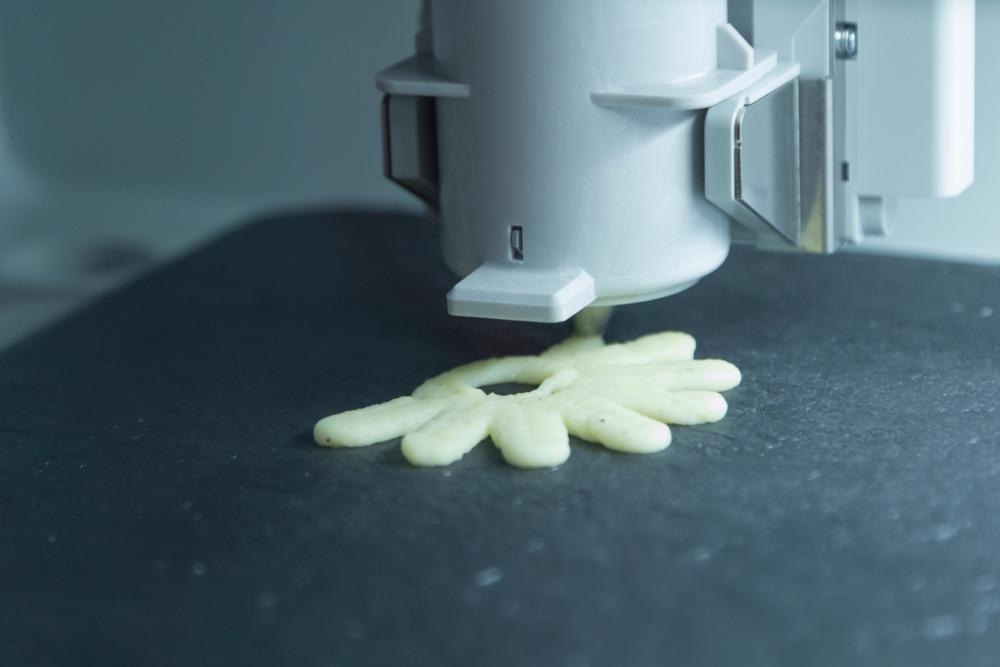Three-dimensional (3D) food printing methods have received considerable attention due to growing living standards and higher consumer demand for innovative food. Rheology fills the gap between edible inks and printability, and its principles determine the flowability, shearing dependence, and thermal endurability of edible inks. The present article discusses the effect of rheological properties on 3D printability in the food industry.

Image Credit: KittyVector/Shutterstock.com
3D Printing in Food Technology
3D printing is recognized as additive manufacturing that relies on digital model files to control the added inks in a layered manner to build 3D structures of different inks. 3D printing has gained significance in recent years because of its intricate shape, design freedom, low production cost, applicability to complex structures, smaller manufacturing cycle, personable customization, and nutrition delivery.
Food printing technology is greatly driven by the development of rheology, and its performance is important to improve the ink formulation that provides pre-evaluation on ink printability, filling the gap between edible inks and practical printing. Ink ingredients determine rheology properties like viscosity, pseudoplastic properties, and shear thinning that drive the printing procedure.
Printable materials like biopolymers are related to the structure and matrix of the ink system that determines the stability, rheology, mechanical strength, and dryness of edible inks. The formulations of edible inks include high-purity biopolymers like polysaccharides, proteins, and fat, and food materials such as fruit, vegetables, meat, cereals, grains, and their extracts/ pastes/mixes/pulping. Proper formulation of these types of ingredients promotes the rheology of final edible inks and leverages the functional groups to produce satisfying structures from printing.
Analyzing Rheological Properties
The rheological properties are extremely important in processing edible inks as well as in subsequent printing. The rheological analysis includes flow investigation and capturing of the microstructure of the fluid under different conditions. Rotational and oscillatory rheological tests are convenient tools to characterize ink rheology.
An ideal printing material should have appropriate viscosity and yield stress. Few previous reports revealed that the composition of edible ink affects the viscosity and the corresponding flowability, thus affecting the printing process. It was previously reported that the moisture content influences the extrusion of the printing material.
Edible ink with a very low moisture content had difficulty extruding from the nozzle due to the high viscosity that would result in poor flowability of the ink, thus impeding the printability. Although a high moisture content could ease the extrusion, the printed sample will have poor structural properties and would collapse during 3D printing. Hence an optimal amount of moisture content is necessary for better extrusion and shape retention.

Image Credit: foto_diego/Shutterstock.com
Shearing dependence, a rheological fingerprint, has a vital role in the practical smooth printing of edible inks and is caused by disentanglement and orientation of the polymer chains during flow. When an external shear is applied during printing, it causes a decrease in viscosity and facilitates the edible ink to go through an anilox roller, screen mesh, or nozzle with special size and geometry, resulting in highly efficient printing.
Thermal endurability is the structural resistance in edible ink toward temperature changes. Further, the temperature is known to affect the rheological properties of food material and, in turn, is expected to influence the final printability of edible inks.
Viscosity strongly varies with the temperature because it is closely linked to molecular motion like Brownian movement. Increasing the temperature could decrease the apparent viscosity of inks because of the thermal expansion of the molecules in ink, leading to increased molecular thermal motion, enhanced molecular diffusion, and weakened intermolecular interaction with the changed molecular structure.
Recent Studies
In an article recently published in the journal Food Hydrocolloids, researchers investigated the 3D printability, rheological properties, and microstructure of biogel inks containing 20% (BG1), 30% (BG2), 50% (BG3), 70% (BG4) and 80% (BG5) fractions of beeswax oleogel. The results revealed that 80% oleogel fraction was the optimum formulation for 3D printing. In terms of the extrudability in 3D printing, the consistency index (K) increased but the behavior index (n) decreased as oleogel fraction increased, which indicated that the viscosity and shearing thinning properties increased.
In another article published in the Journal of Food Engineering, the researchers analyzed the effect of the particle sizes (307, 259, 172, and 50 μm) on rheological properties and printing performance for a food-ink dispersion system where 20% (w/w) of spinach powder was incorporated in 10% (w/w) xanthan gum mixture was investigated.
The shear modulus of spinach dispersion was ranged from 2.97 ± 1.26 kPa for finest size (50 μm) to 6.43 ± 1.41 kPa for a particle size of 307 μm and increased with increasing particle size. All dispersions were printed smoothly regardless of the particle size. The results obtained in this study suggest that increasing the particle size of the incorporated food powder can achieve an efficient mechanical strength increase.
To conclude, edible ink is an advanced development in the food industry and rheological analysis can establish a close connection between edible ink and its printability. Rheology has attracted the attention of researchers to develop the field of food technology, bringing outstanding breakthroughs.
More from AZoM: What is Glow Discharge Optical Emission Spectrometry
References and Further Reading
Cheng, Y., Fu, Y., Ma, L., Yap, P. L., Losic, D., Wang, H., and Zhang, Y. (2022). Rheology of edible food inks from 2D/3D/4D printing, and its role in future 5D/6D printing. Food Hydrocolloids, 107855.
https://www.sciencedirect.com/science/article/abs/pii/S0268005X22003757
Qiu, R., Wang, K., Tian, H., Liu, X., Liu, G., Hu, Z., and Zhao, L. (2022). Analysis on the printability and rheological characteristics of bigel inks: Potential in 3D food printing. Food Hydrocolloids, 129, 107675. https://www.sciencedirect.com/science/article/abs/pii/S0268005X22001953
Lee, J. H., Won, D. J., Kim, H. W., and Park, H. J. (2019). Effect of particle size on 3D printing performance of the food-ink system with cellular food materials. Journal of Food Engineering, 256, 1-8.
https://www.sciencedirect.com/science/article/abs/pii/S0260877419301128
Disclaimer: The views expressed here are those of the author expressed in their private capacity and do not necessarily represent the views of AZoM.com Limited T/A AZoNetwork the owner and operator of this website. This disclaimer forms part of the Terms and conditions of use of this website.